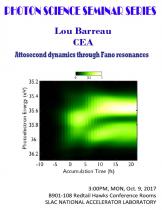Speaker: Lou Barreau of CEA
Program Description:
Autoionization arises when an atom or a molecule is excited to a quasi-bound state above its ionization potential. The interferences between the quasi-bound state and the neighboring continuum through configuration interaction, first described by Fano [1], lead to an asymmetric line shape in the spectral domain and a typical lifetime of tens of femtoseconds in the temporal domain. The lifetime is not sufficient to describe entirely the autoionization dynamics, in particular the above-mentioned interferences at birth time. This information is encoded in the complex transition amplitude, and thus requires the measurement of its amplitude and phase [2].
The recent progress in attosecond spectroscopy is making possible the spectral characterization of this resonant electron wave packet. Using spectrally-resolved electron interferometry, the so-called Rainbow RABBIT method, we fully characterize the electron wave packet emitted through a Fano resonance [3]. This allows reconstructing the complete ionization dynamics, including the resonance buildup. This evidences how photoelectron wave packets are born and morph into asymmetric Fano profiles.
[1] U. Fano, Phys. Rev. 124, 1866 (1961).
[2] M. Kotur et al., Nat. Commun. 7, 10566 (2016).
[3] V. Gruson et al., Science 354, 734 (2016).





